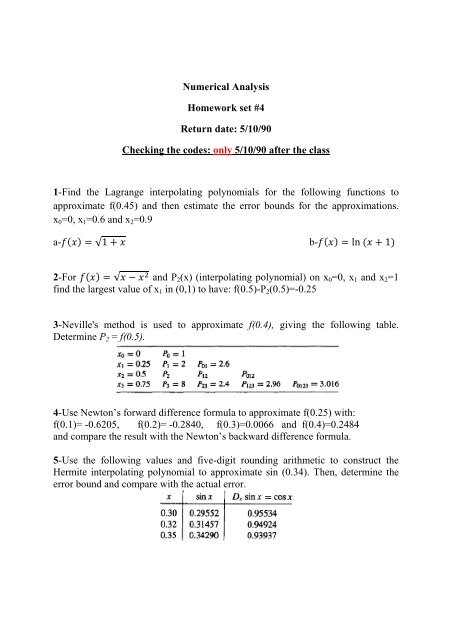Numerical Analysis Homework set #4 Return date: 5/10/90 ...
Numerical Analysis Homework set #4 Return date: 5/10/90 ... Numerical Analysis Homework set #4 Return date: 5/10/90 ...
Numerical AnalysisHomework set #4Return date: 5/10/90Checking the codes: only 5/10/90 after the class1-Find the Lagrange interpolating polynomials for the following functions toapproximate f(0.45) and then estimate the error bounds for the approximations.x 0 =0, x 1 =0.6 and x 2 =0.9a- √1 b- ln 12-For √ and P 2 (x) (interpolating polynomial) on x 0 =0, x 1 and x 2 =1find the largest value of x 1 in (0,1) to have: f(0.5)-P 2 (0.5)=-0.253-Neville's method is used to approximate f(0.4), giving the following table.Determine P 2 = f(0.5).4-Use Newton’s forward difference formula to approximate f(0.25) with:f(0.1)= -0.6205, f(0.2)= -0.2840, f(0.3)=0.0066 and f(0.4)=0.2484and compare the result with the Newton’s backward difference formula.5-Use the following values and five-digit rounding arithmetic to construct theHermite interpolating polynomial to approximate sin (0.34). Then, determine theerror bound and compare with the actual error.
<strong>Numerical</strong> <strong>Analysis</strong><strong>Homework</strong> <strong>set</strong> <strong>#4</strong><strong>Return</strong> <strong>date</strong>: 5/<strong>10</strong>/<strong>90</strong>Checking the codes: only 5/<strong>10</strong>/<strong>90</strong> after the class1-Find the Lagrange interpolating polynomials for the following functions toapproximate f(0.45) and then estimate the error bounds for the approximations.x 0 =0, x 1 =0.6 and x 2 =0.9a- √1 b- ln 12-For √ and P 2 (x) (interpolating polynomial) on x 0 =0, x 1 and x 2 =1find the largest value of x 1 in (0,1) to have: f(0.5)-P 2 (0.5)=-0.253-Neville's method is used to approximate f(0.4), giving the following table.Determine P 2 = f(0.5).4-Use Newton’s forward difference formula to approximate f(0.25) with:f(0.1)= -0.6205, f(0.2)= -0.2840, f(0.3)=0.0066 and f(0.4)=0.2484and compare the result with the Newton’s backward difference formula.5-Use the following values and five-digit rounding arithmetic to construct theHermite interpolating polynomial to approximate sin (0.34). Then, determine theerror bound and compare with the actual error.
6-A car traveling along a straight road is clocked at a number of points. The datafrom the observations are given in the following table, where the time is inseconds, the distance is in feet and the speed is in feet per second.a. Use a Hermite polynomial to predict the position of the car and its speed whent= l0 s.b. Use the derivative of the Hermite polynomial to determine whether the car everexceeds a 55 mi/h speed limit on the road. If so, what is the first time the carexceeds this speed?c. What is the predicted maximum speed for the car?7-Determine the free cubic spline S that interpolates the data f(0) = 0, f(1) = 1, andf(2) =28-A clamped cubic spline s for a function f is defined on [1, 3] byGiven f ' (1) = f ' (3), find a, b, c, and d.Computer codes1-Write a computer code for Neville’s iterated interpolation and solve an example.2- Write a computer code to find the coefficients for Newton’s divided differenceformula and solve an example.



